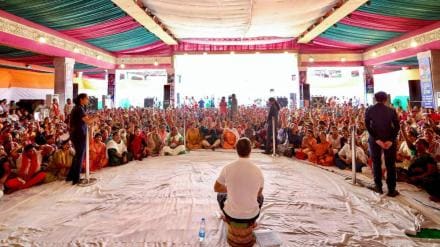There are things that we see but do not notice. There are things that we read but they do not register. There are things that make us flinch but we shrug them off. That is the reality of existence (we call it living) of Indians, a substantial number poor, fighting prejudice and discrimination, fiercely competitive, and driven by conflicting aspirations.
Drive down near midnight on Kolkata’s Central Avenue: few will notice the number of people sleeping on the roadside or ask why these people do not have a shelter at night? Drive through any junction of roads in Delhi: the number of children who beg or sell flowers or towels or pirated books will not trigger the obvious question, why are these children not in school? Drive through the parched, dry lands in many parts of India, there is no sign of water, nothing seems to grow on the land, yet thousands of people live on the land, and few will wonder what is their source of livelihood?
Congress’ manifesto LS 2024 acknowledged that, over the years, especially in the last three decades, India’s economy has grown. The growth manifested itself in the burgeoning middle class, abundance of consumer goods, a mobile phone in every hand, good inter-state roads, and the spanking malls, cinemas and pubs that have become the ‘town squares’ of urban India. However, the picture of ‘shining India’, cannot hide the ugly truths that are at once a reminder of our failures and an opportunity to correct our course.
Economy mirrors society
UNDP drew the poverty line at earnings per person per month of Rs 1286 (urban) and Rs 1089 (rural), and estimated the number of poor persons in India at 22.8 crore. If anything, it is a gross underestimate. According to the World Inequality Lab, the bottom 50 per cent of the people (71 crore) own 3 per cent of the national wealth and earn 13 per cent of the national income. The government’s Household Consumption Expenditure Survey (HCSE) estimates the household consumption per month of the bottom 50 percent as Rs 3094 (rural) and Rs 2001 (urban). It does not require great mathematical skills to estimate the consumption expenditure of the bottom 20 per cent of the people. They practically own nothing, earn little and, as a household, consume barely enough to exist on this earth. On the Global Hunger Index, India’s rank is 111 out of 125 countries.
Of the poor, according to the HCSE, the OBC are near the average level and the SC and ST are the poorest. It is no surprise that the economic hierarchy mirrors the social hierarchy that has been entrenched in the country for thousands of years, and the social hierarchy is based on caste. The very poor and the very oppressed do hard scrabble manual work at the bare minimum wage. 15.4 crore persons are active, registered workers under MGNREGA. They are given work, on average, for 50 days a year.
Meanwhile, at the other end, the top 10 per cent of the population earn 57.7 per cent of the national income. The share of just 9223 individuals is 2.1 per cent and the share of just 92,234 individuals is 4.3 per cent. Carrying a price tag per car of between Rs 3.22 crore and Rs 8.89 crore, 103 Labhorginis were sold in India in 2023. The rich showed their gratitude when, apart from corporates, 362 individuals bought the infamous electoral bonds worth Rs 757 crore and ‘donated’ the sum to political parties. All political parties are beholden to their donors.
Have achche din arrived? Has India or have Indians become Atmanirbhar? India’s trade deficit with China alone (yes, the country whose troops have occupied Indian territory and barred patrolling by Indian troops) was USD 100 billion in 2023-24. Is this the dawn of Amrit Kaal? For how long will the people be deceived and lied to?
The two markers
Unless political parties acknowledge that the two markers of Indian polity and economy are caste and inequality, we cannot strike at the root of poverty, discrimination and oppression. Congress’ manifesto drew attention to the dark side of the BJP’s narrative of ‘development’ and made a few simple promises to key stakeholders:
To the SC, ST & OBC
- To conduct a nation-wide socio-economic and caste census and collect the data that will strengthen the agenda for affirmative action.
- To lift the 50 per cent cap on reservations for SC, ST and OBC.
- To fill all the backlog vacancies in posts reserved for SC, ST and OBC within one year.
To the youth
- To pass a Right to Apprenticeship Act, guarantee a one-year apprenticeship and a stipend of Rs 100,000 a year, and provide jobs.
- To fill the nearly 30 lakh vacancies in the central government.
- To waive outstanding education loans and unpaid interest.
To women
- To launch the Mahalakshmi scheme and provide Rs 100,000 a year to the poorest families.
- To raise the minimum wage for MGNREGA work to Rs 400 per day.
- To reserve 50 per cent of central government jobs for women.
Pivot to the poor
The guiding principle of the new government that will be elected in June 2024 must be ‘pivot to the poor and the excluded’. Congress’ manifesto acknowledged this obligation; hence it became the ‘talking point’ throughout the country. The BJP spent most of its lung power and money power denouncing the Congress’ manifesto or, rather, the imaginary version.
As the election rolled through the seven phases, the battle was joined between those determined to protect the status quo and those determined to disrupt the status quo. Keep your fingers crossed until June 4.
